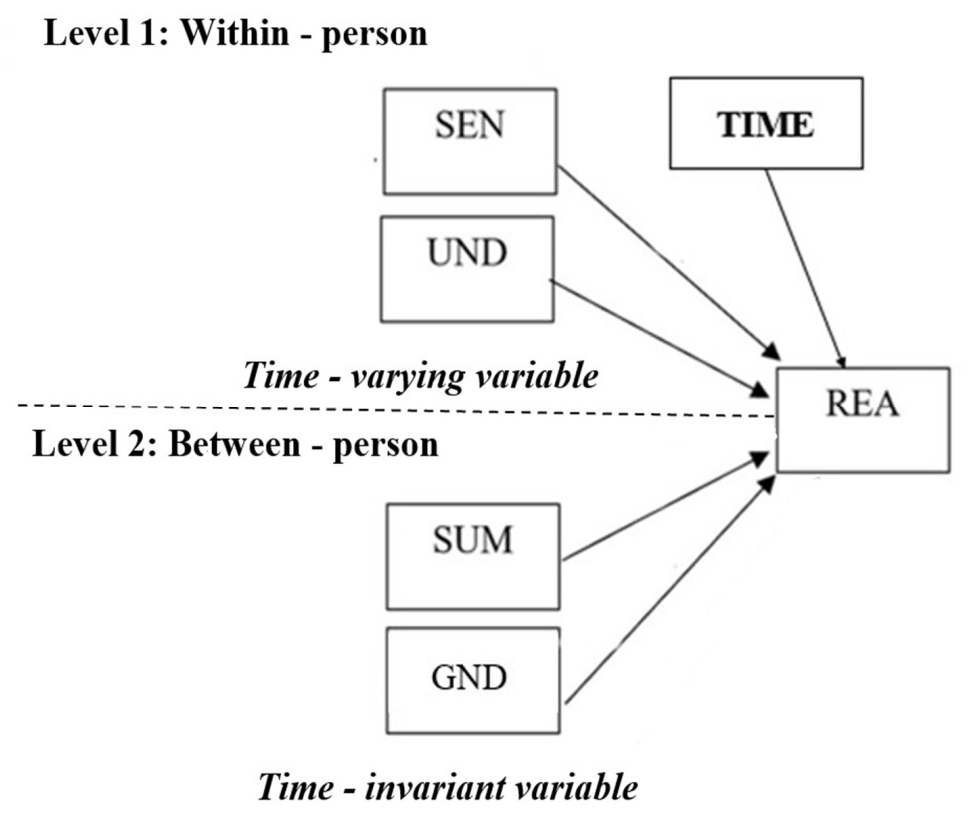Analysis of Growth Curve Modeling of Students’ Moral Reasoning on Applications of Modern Biotechnology
Keywords:
Application of Modern Biotechnology, Growth Curve Modeling, Moral ReasoningAbstract
This study examined the growth of students’ moral reasoning on the moral dilemma of applications of modern biotechnology. A total of 206 high school students participated in this study. They underwent four waves of assessment over one semester. We validated a hypothesized model of longitudinal data using a multilevel analysis framework by Mplus 8.0. The results showed that 32.6% of the total variance was due to individual differences (intraclass coefficient = .326). There was variation in terms of students’ initial moral reasoning scores ( = 2.719, p < .001). At an intrapersonal level, moral reasoning can be explained by time and moral sensitivity. Moral reasoning would increase by 0.19 point in each subsequent measurement (p < .05). At an interpersonal level, the mean of initial moral reasoning was 11.33 points (p < .01) and at the initial point, girls scored 1.377 points more than boys on the moral reasoning measure. Knowledge of DNA technologies and previous biology achievement could not explain the within- and between-person variance of moral reasoning, respectively. The pedagogical implications for moral education were also discussed.
References
American Association for the Advancement of Science (AAAS). (1990). Science for All Americans. Oxford University Press.
Andrew, J., & Robottom, I. (2001). Science and ethics: Some issues for education. Science Education, 85, 769–780. https://doi.org/10.1002/sce.1038
Bryk, D.T., & Raudenbush, S. W. (1992). Hierarchical linear model: Applications and data analysis methods. Sage.
Clarkeburn, H. (2002). A test for ethical sensitivity in science. Journal of Moral Education, 31(4), 439–453. https://doi.org/10.1080/0305724022000029662
Črne-Hladnik, H., A. Hladnik, B. Javornik, K. Košmelj and C. Peklaj. (2012). Is judgment of biotechnological ethical aspects related to high school students' knowledge? International Journal of Science Education, 34(8), 1277–1296.
https://doi.org/10.1080/09500693.2011.572264
Dawson, L. M. (1992). Will feminization change the ethics of the sales profession? Journal of Personal Selling and Sales Management, 21–32.
https://www.jstor.org/stable/40471451
Dawson, V. M. & Taylor, P.C. (1999). Teaching bioethics in science: Does it make a difference? Australian Science Teachers’ Journal, 45, 59–64.
Dawson, V. M., & Schibeci R. A. (2003). West Australian school students’ understanding of Biotechnology. International Journal of Science Education, 25, 57–69. https://doi.org/10.1080/09500690210126720
Evans, J. H. (2002). Playing God?: Human genetic engineering and the rationalization of public bioethical debate. University of Chicago Press.
Fowler, S. R., Zeidler, D. L., & Sadler, T. D. (2009). Moral sensitivity in the context of socioscientific issues in high school science students. International Journal of Science Education, 31(2), 279–296.
https://doi.org/10.1080/09500690701787909
Gilligan, C. (1993). In a different voice: Psychological theory and women’s development. Harvard University Press.
Grace, M. M., & Ratcliffe, M. (2002). The science and values that young people draw upon to make decisions about biological conservation issues. International Journal of Science Education, 24, 1157–1169.
https://doi.org/10.1080/09500690210134848
Hair, J. F., Hult, G. T. M., Ringle, C. M., & Sarstedt, M. (2022). A Primer on Partial Least Squares Structural Equation Modeling (PLS-SEM) (3rd ed.). Sage.
Hart, D. (2005). The Development of Moral Identity. In G. Carlo & C. P. Edwards (Eds.), Moral motivation through the life span (pp. 165–196). University of Nebraska Press.
Hox, J. (2010). Multilevel analysis: Techniques and applications. Routledge.
Kohlberg, L. (1969). Stage and sequence: The cognitive developmental approach to socialization. In D. Goslin (Ed.), Handbook of socialization theory and research (pp. 347–480). Rand McNally.
McCoach, D. B., & Kaniskan B. (2010). Using time-varying covariates in multilevel growth models. Frontiers in Psychology, 1, 1–12.
https://doi.org/10.3389/fpsyg.2010.00017
National Research Council of Thailand. (2013). Teachers and strengthening ethics to students. Bangkok. [in Thai]
Olsher, G., & Dreyful, A. (1999). The ‘ostension-teaching approach as a means to develop junior-high student attitudes towards biotechnologies. Journal of Biological Education, 34, 24–30.
https://doi.org/10.1080/00219266.1999.9655679
Pedretti, E. (1999). Decision making and STS education: Exploring science knowledge and social responsibility in schools and science centers through an issues-based approach. School Science and Mathematics, 99, 174–181.
https://doi.org/10.1111/j.1949-8594.1999.tb17471.x
Piaget, J. (1932). The moral judgment of the child. Harcourt, Brace.
Raudenbush, S. W., & Bryk, A. S. (2002). Hierarchical linear models: Application and data analysis methods (2nd ed.). Sage.
Rest, J. R. (1986). Moral development: Advances in research and theory. Praeger.
Sadler, T. D., & Zeidler, D. L. (2005a). Patterns of informal reasoning in the context of socio-scientific decision-making. Journal of Research in Science Teaching, 42(1), 112–138. https://doi.org/10.1002/tea.20042
Sadler, T. D., & Zeidler, D. L. (2005b). The significant of content knowledge for informal reasoning regarding socioscientific issues: Applying genetics knowledge to genetic engineering issues. Science Education, 89(1), 71–93.
https://doi.org/10.1002/sce.20023
Singer, J. D., & Willet, J. B. (2003). Applied longitudinal data analysis. Oxford University Press.
Stock, G., & Campbell, J. (2000). Engineering the human germline: An exploration of the science and ethics of altering the genes we pass to our children. Oxford University Press.
Zeidler. D. L. (1984). Moral issues and social policy in science education: Closing the literacy gap. Science Education, 68, 411–419.
https://doi.org/10.1002/sce.3730680406
Zohar, A., & Nemet, F. (2002). Fostering students’ knowledge and argumentation skills through dilemmas in human genetics. Journal of Research in Science Teaching, 39, 35–6. https://doi.org/10.1002/tea.10008

Downloads
Published
How to Cite
Issue
Section
License
Copyright (c) 2024 The Authors

This work is licensed under a Creative Commons Attribution-NonCommercial-NoDerivatives 4.0 International License.
All published content in JRM is licensed under a Creative Commons Attribution-NonCommercial-NoDerivatives 4.0 International License (CC BY-NC-ND 4.0).


